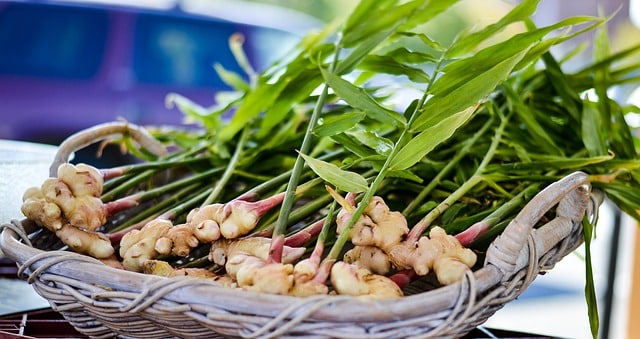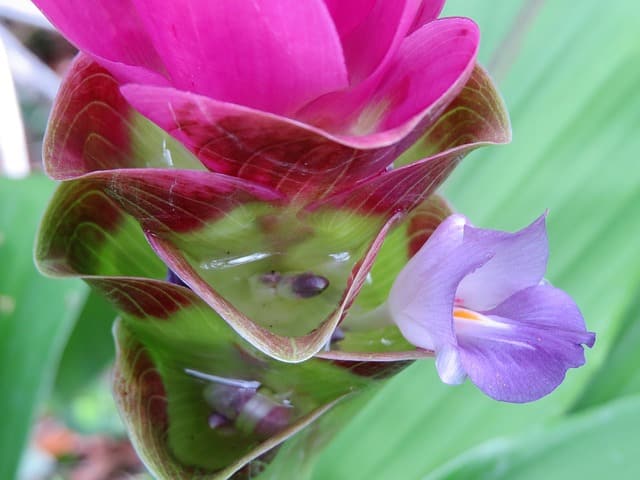Hi, my loves and welcome to WiccaNow. Recently I’ve been sharing guides to all of my favourite magickal herbs and plants, like this post all about the magickal properties of catnip. I’ve also shared a post about how to use comfrey in magick, another explaining daisy magick, a post about elderberry and most recently a guide to the magickal properties of fennel. Today I want to continue in this vein by sharing my guide to the magickal properties of ginger with you.
Ginger is one of the first spices that was imported into Europe. It has an extremely long history as a healing herb and is used to treat nausea, pain, inflammation and colds. The magickal properties of ginger are varied and include love, success, protection, luck and many more.

Disclaimer: Any medicinal benefits given here are a product of my own research and as such should not be taken over the advice of trained medical professionals. If you are ill, please go and see a doctor. Always make sure that anything you consume is 100% safe. If you are pregnant, consult your doctor or midwife before consuming something you haven’t tried before.
History of Ginger
Ginger, also known as Zingiber officinale, is a flowering plant which produces a rhizome that is widely used as a spice and in traditional medicine. Ginger is part of the Zingiberaceae family which also contains turmeric, galangal and cardamom.
It’s believed that ginger has been cultivated for at least 5000 years, having originated in Island Southeast Asia. It’s a cultigen, meaning that it was deliberately bred and doesn’t actually exist in a wild state. It was used widely by the Austronesian peoples for multiple purposes, from food, to medicine to material to make mats with. It also had a religious significance and was used ritually when asking for protection from spirits and for healing ceremonies.
The Austronesian peoples took ginger with them when they voyaged to other islands, and in this way they introduced ginger to the Pacific Islands. Its thought that they also brought it to India from where it was brought to the Middle East and the Mediterranean by traders around the 1st century AD.

The first written record of ginger came from non other than the famous Confucius (475-221BC), who wrote that you should eat it with every meal. In 406AD the famous Buddhist monk Faxian (337-422AD) wrote about ginger being grown in pots on ships in order to stave off scurvy. By the Song Dynasty (960-1279AD) ginger was imported to China from other southern countries.
By the time Dioscorides (40-90AD) was writing about healing herbs and plants, ginger had already been introduced to the Mediterranean. In 150AD ginger is mentioned by Ptolemy who states that it was being imported from Ceylon.
Ginger was a very popular spice in Ancient Rome, where it was prized for its medicinal properties and supposed help with fertility. Due to its cost, it was seen as a symbol of wealth. It continued to be a highly sought after commodity in Europe even after the Roman Empire fell. Middle Eastern merchant controlled the ginger and spice trade for centuries. In the 1100s, tariffs were placed on ginger imports in Marseilles.
In 1200-1300 in England, a pound of ginger was expensive and cost around the same as a sheep. By Medieval times, ginger was being imported readily into Europe in both raw and preserved forms, although at this time preserved ginger was favoured to use in sweets. Queen Elizabeth I is thought to have invented the gingerbread man, which then became a popular treat at Christmas. She had it made because her father had recommended ginger as a remedy for the plague. Interesting and slightly frightening origins for such a delicious treat.
Spanish Conquistadors introduced ginger to the New World and brought it to the Caribbean where it flourished. Native Americans also started using ginger as treatments for various ailments and also as a flavouring agent for their food.

Today ginger is found in many spice cabinets all over the world. It’s a common treatment for colds and flu (in my family anyway) and is often prescribed in tablet form to those who suffer from seasickness.
Fun Facts about Ginger
- India is currently the worlds largest producer of ginger. In 2018, India produces 32% of the worlds ginger.
- While India is the biggest producer, it actually doesn’t export very much and only accounts for 1.17% of the total ginger exports.
- Ginger is time consuming and difficult to farm, with around 65% of the sales price going toward labour, seed and material costs.
- Dry ginger is most commonly used around the world compared to raw or preserved ginger.
- Traditional Chinese medicine believes that ginger will treat the whole human body. This is because when it is harvested, ginger roots often look like they could have a head, legs and arms.
- You can make wine out of ginger. Ginger beer will also almost always turn alcoholic. If you make ginger beer, be careful with the bottles as they love to explode. Yes, this has happened to me more than once.
- The name ginger comes from the Sanskrit word “srngaveram” which means “horn root” after ginger roots appearance. This was translated to the Latin “gingiber” and then to Old English “gingibre” which has now turned into just “ginger”.
- The flowers of the ginger plant are very pretty and are often added to decorative borders in gardens with a warm enough climate to support its growth.
- The stems aren’t actually stems, but tightly rolled up leaves.
- The ancient Greeks would eat ginger wrapped in bread after a large meal to aid digestion.
- The ancient Austronesians used it to bless ships.
- Hawaiians used to drink ginger juice from the stems of the flower heads after hiking.
- Ginger was one of the first spices to be introduced to Europe.

Medicinal Benefits of Ginger
Ginger is considered safe to consume in reasonable quantities. It’s on the FDAS “generally recognized as safe” list. It does interact with some medications, so if you are taking anticoagulants or heart medication in particular, definitely check with your doctor before consuming ginger as a health tonic.
Ginger is very high in a substance called “gingerol” which is why it’s so high in antioxidants and is what makes ginger such a powerful anti-inflammatory aid.
Ginger can be consumed in all its forms, although it’s thought that consuming it raw gives the most health benefits.

- Anti-inflammatory
- Antioxidant
- Helps to reduce gas
- Helps ease nausea
- A great remedy for seasickness
- Might help muscle pain in the long term
- May help to ease the symptoms of colds and flu
- May help those suffering from osteoarthritis
- May lower blood sugars
- May improve oral health
- May help to treat chronic indigestion
- May help to relieve menstrual pain
- May lower cholesterol
- May help to protect against Alzheimer’s disease
- May improve brain function
- Helps to fight infection
Magickal Properties of Ginger
Use the magickal properties of ginger is to boost the strength of any other ingredients you’re working with. It has a very strong energy though so don’t use it to enhance more delicate ingredients and it may have unwanted effects or over power the magickal properties of the other ingredients you are working with.
Using ginger in abundance and prosperity spells is wonderful. The magickal properties of ginger have a particular affinity with manifesting abundance and warding away poverty. Invite good fortune into you home by keeping a small ginger plant in a pot.

If you chew raw ginger or drink ginger tea before doing any magickal work, you will increase your own energy which will in turn make the spell more successful.
Ginger is considered an aphrodisiac, so use it in love spells to do with passionate love. It will also help to increase your confidence so drink a little ginger tea before heading out on a date that you might be nervous about.
If you want to smoke cleanse your home or your tools, use dried ginger. It keeps away malevolent energy and drives out any negativity you may have been feeling. If you suffer from nightmares, place some ginger under your bed in order to ease the nightmares and make you feel calmer.
Other Magickal Properties of Ginger
- Love
- Passion
- Protection
- Abundance
- Healing
- Luck
- Sensuality
- Sexuality
- Success
- Prosperity
Magickal Associations of Ginger
Deities – Hecate, Ameretat, Artemis
Magickal Correspondences of Ginger
Zodiac – Aries
Planet – Mars
Element – Fire
Gender – Masculine
Crystals – Citrine, carnelian, pyrite and garnet

So my lovelies, I hope that this guide answers all of your questions about the magickal properties of ginger! May your endevors be successful, your life filled with love and your energies strong and powerful.
Until next time,
Blessed be,
Amaria xx
